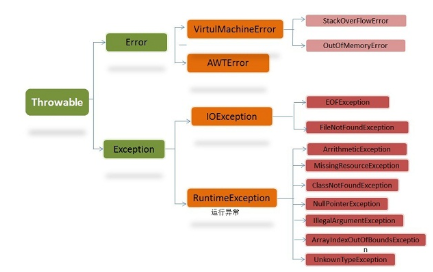异常
异常
Exception
// 异常
public class Demo01 {
public static void main(String[] args) {
// System.out.println(11/0);
}
}
运行结果:

简单分类
- 检查性异常:最具代表的检查性异常是用户错误或问题引起的异常
- 运行时异常
- 错误ERROR:错误不是异常,而是脱离程序员控制的问题。
异常体系结构
-
Java把异常当作对象来处理,并定义一个基类java.lang.Throwable作为所有异常的超类
-
在Java API中已经定义了许多异常类,这些异常类分为两大类,错误Error和异常Exception

异常处理机制
- 抛出异常
- 捕获异常
- 异常处理五个关键字
- try、catch、finally、throw、throws
public class Test {
public static void main(String[] args) {
int a = 1;
int b = 0;
try{
if (b==0){// throw throws
throw new ArithmeticException();// 主动的抛出异常
}
System.out.println(a/b);
// 假设要捕获多个异常: 从小到大!
}catch (Error e){// catch(想要捕获的异常类型) 捕获异常
System.out.println("Error");
}catch (Exception e){
System.out.println("Exception");
}catch (Throwable e){
System.out.println("Throwable");
}finally {// 处理善后工作
System.out.println("finally");
}
// finally 可以不要 finally, 假设IO, 资源,关闭!
}
运行结果:

public class Test2 {
public static void main(String[] args) {
int a = 1;
int b = 0;
// 选中 Ctrl+ Alt + T try/catch/finally
try {
System.out.println(a/b);
} catch (Exception e) {
// System.exit(1); 程序手动结束
e.printStackTrace();// 打印错误的栈信息
} finally {
}
}
}
运行结果:

public class Test {
public static void main(String[] args) {
try {
new Test().test(1, 0);
} catch (ArithmeticException e) {
e.printStackTrace();
}
}
// 假设这方法中,处理不了这个异常,方法上抛出异常
public void test ( int a, int b){
if (b == 0) {// throw throws
throw new ArithmeticException();// 主动的抛出异常
}
}
}
运行结果:

自定义异常
- 创建自定义异常类
- 在方法中通过throw关键字抛出异常对象
- 如果在当前抛出异常的方法中处理异常,可以使用try-catch语句捕获并处理;否则在方法的声明处通过throws关键字指明要抛出给方法调用者的异常,继续进行下一步操作
- 在出现异常方法的调用者中捕获并处理异常
// 自定义异常类
public class MyException extends Exception{
// 传递数字>10;
private int detail;
public MyException(int a) {
this.detail = a;
}
// toString:异常的打印信息
@Override
public String toString() {
return "MyException{" + detail + '}';
}
}
public class Test {
// 可能会存在的方法
static void test(int a) throws MyException {
System.out.println("传递的参数为:"+a);
if (a>10){
throw new MyException(a);// 抛出
}
System.out.println("OK");
}
public static void main(String[] args) {
try {
test(11);
} catch (MyException e){
// 增加一些处理异常的代码~
System.out.println("MyException=>"+e);
}
}
}
运行结果:

推荐免费课程
任何时候开始,都为时不晚。




 浙公网安备 33010602011771号
浙公网安备 33010602011771号